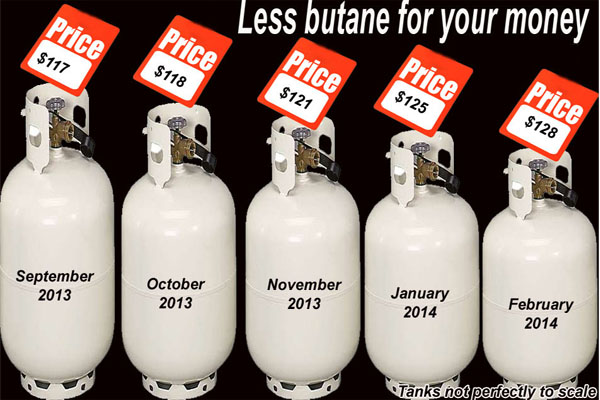Butane buyers are seeing the second consecutive price hike since the year began, and with new prices taking effect on Saturday, February 8, 2014, Punta Gorda residents may pay up to $133 for a 100-pound cylinder of liquefied petroleum gas (LPG), cooking gas composed of a mixture butane and propane.
Controller of Supplies José Trejo told Amandala that this weekend’s price increase reflects changes on the world market, due to a high demand for fuel to meet heating costs in countries such as the United States, which have been facing harsh weather conditions.
He told us that higher demand and low supply has meant escalating prices, and Belize’s prices have been adjusted to account for price spikes on the foreign market.
According to Trejo, the Mont Belvieu Index, which reflects prices out of Houston, Texas, is used to calculate the regulated price of LPG in Belize.
Belize City residents will pay $126 for a 100-pound tank of LPG if it was imported from Central America. What we have been calling “butane” is not really 100% butane. The Central American butane, said to be the less efficient LPG, which only has 10% butane, and the other 90% is propane – which burns faster.
Meanwhile, a Belize City resident who purchases from a distributor which sells Mexican LPG will get 60% propane and 40% butane, but pay only $2.00 more – at $128 for the 100-pound cylinder. (See accompanying chart for district prices.)
When higher prices took effect this January, the price spread between the less efficient butane and the more efficient butane was $4; today, they are both just as expensive, with the price spread having narrowed substantially.
The cumulative price increase has also been substantial. In July 2012, when the two-tier price structure was first implemented, 90:10 LPG was just $97 on the 100-pound tank, while the 60:40 LGP was tagged at $104. For the past one year and eight months, this has represented an overall price increase of 30% for the Central American LPG and 23% for the Mexican LPG.
Belize’s prices are based on the acquisition cost of the LPG, the landed cost, including the freight cost, and taxes, such as the environmental tax.
Trejo told Amandala that a change in the Mont Belvieu Index in Texas is what drove the latest LPG increase.
We asked him what has been the history of the Government subsidizing or buffering these LPG price increases, and he told us that back in 2008 price spikes were tempered by staggering the price increases over time, but the Government did not absorb those price increases by easing on the tax levies, as it had been known to do when fuel prices became crippling at the pumps.

